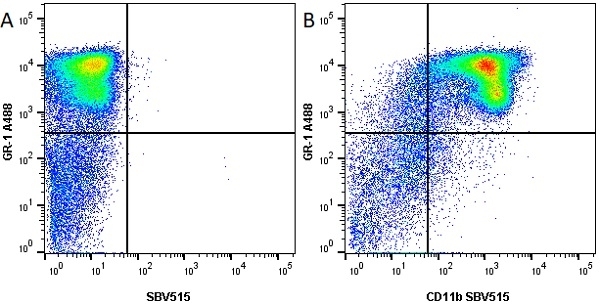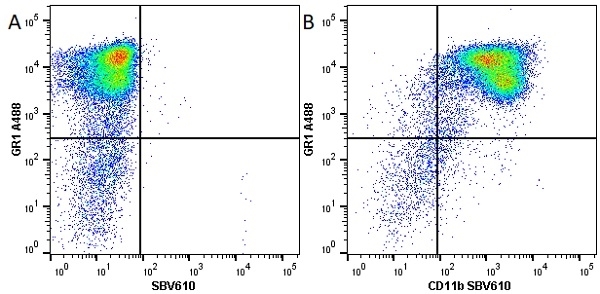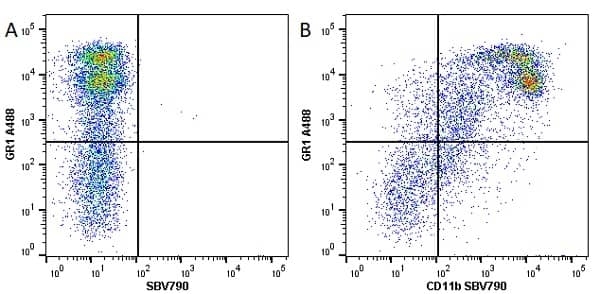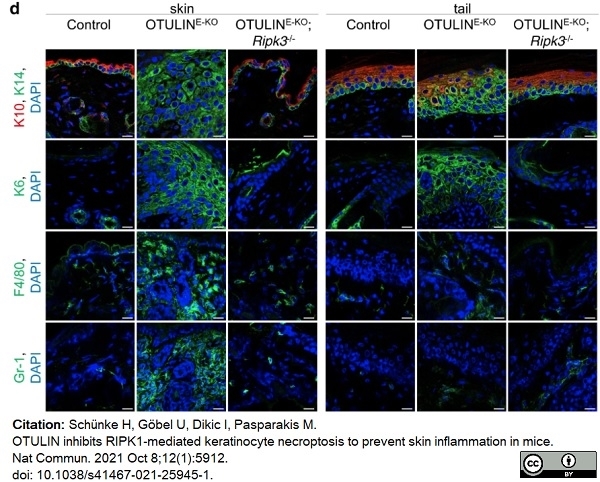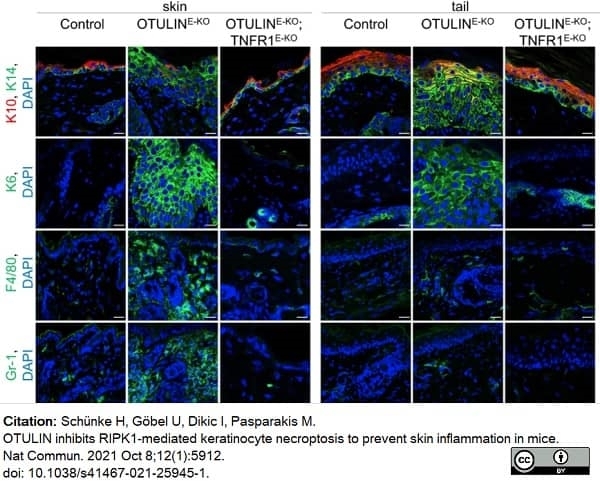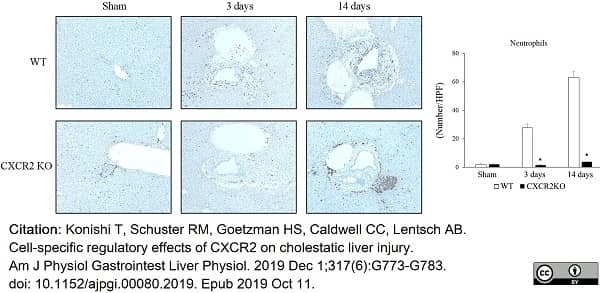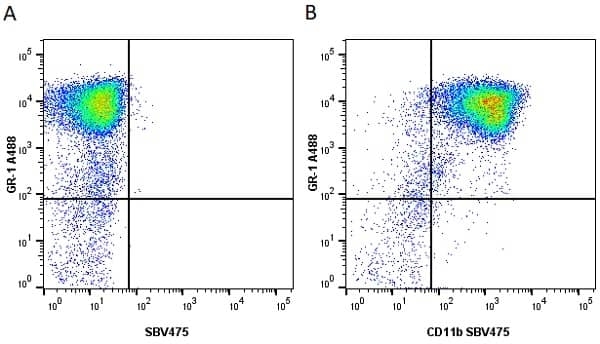Gr-1 antibody | RB6-8C5




































Rat anti Mouse Gr-1:FITC
- Product Type
- Monoclonal Antibody
- Clone
- RB6-8C5
- Isotype
- IgG2b
- Specificity
- Gr-1
| Rat anti Mouse Gr-1 antibody, clone RB6-8C5 recognizes the mouse Gr-1 antigen, a ~21–25 kDa GPI anchored cell surface protein bearing a single uPAR/Ly6 domain that belongs to the Ly-6 family of proteins (Lee et al. 2013). Rat anti Mouse Gr-1 antibody, clone RB6-8C5 reacts predominantly with the Ly-6G protein but weaker reactivity with the Ly-6C protein has been reported (Fleming et al. 1993). However, other observations dispute the cross-reactivity of clone RB6-8C5 with the Ly-6C protein with the alternative explanation that certain sub-populations of bone marrow cells simultaneously express both Ly-6C and Ly-6G (Nagendra et al. 2007) The Gr-1 antigen is primarily a marker of myeloid differentiation. In the bone marrow the level of Gr-1 expression is low on immature myeloblasts and increases as the myeloid cells mature to granulocytes. Gr-1 is also expressed on macrophages and transiently on differentiating monocytes. Rat anti Mouse Gr-1 antibody, clone RB6-8C5 has been used successfully for the depletion of mature neutrophils in vivo (Czuprynski et al 1994, Daley et al. 2008). |
- Target Species
- Mouse
- Product Form
- Purified IgG conjugated to Fluorescein Isothiocyanate Isomer 1 (FITC) - liquid
- Preparation
- Purified IgG prepared by affinity chromatography on Protein G from tissue culture supernatant
- Buffer Solution
- Phosphate buffered saline
- Preservative Stabilisers
- 0.09% sodium azide (NaN3)
1% bovine serum albumin - Immunogen
- Normal murine bone marrow cells.
- Approx. Protein Concentrations
- IgG concentration 0.1 mg/ml
- Max Ex/Em
-
Fluorophore Excitation Max (nm) Emission Max (nm) FITC 490 525 - Regulatory
- For research purposes only
- Guarantee
- 12 months from date of despatch
Avoid repeated freezing and thawing as this may denature the antibody. Storage in frost-free freezers is not recommended. This product is photosensitive and should be protected from light.
| Application Name | Verified | Min Dilution | Max Dilution |
|---|---|---|---|
| Flow Cytometry | Neat |
| Description | Product Code | Applications | Pack Size | List Price | Your Price | Quantity | |
|---|---|---|---|---|---|---|---|
| Rat IgG2b Negative Control:FITC | MCA6006F | F | 0.1 mg |
|
Log in | ||
| List Price | Your Price | ||||||
|
|
Log in | ||||||
| Description | Rat IgG2b Negative Control:FITC | ||||||
| Description | Product Code | Applications | Pack Size | List Price | Your Price | Quantity | |
|---|---|---|---|---|---|---|---|
| Mouse Seroblock FcR | BUF041A | F | 0.1 mg |
|
Log in | ||
| List Price | Your Price | ||||||
|
|
Log in | ||||||
| Description | Mouse Seroblock FcR | ||||||
| Mouse Seroblock FcR | BUF041B | F | 0.5 mg |
|
Log in | ||
| List Price | Your Price | ||||||
|
|
Log in | ||||||
| Description | Mouse Seroblock FcR | ||||||
References for Gr-1 antibody
-
Hestdal, K. et al. (1991) Characterization and regulation of RB6-8C5 antigen expression on murine bone marrow cells.
J Immunol. 147 (1): 22-8. -
Fleming, T.J. et al. (1993) Selective expression of Ly-6G on myeloid lineage cells in mouse bone marrow. RB6-8C5 mAb to granulocyte-differentiation antigen (Gr-1) detects members of the Ly-6 family.
J Immunol. 151 (5): 2399-408. -
Czuprynski, C.J. et al. (1994) Administration of anti-granulocyte mAb RB6-8C5 impairs the resistance of mice to Listeria monocytogenes infection.
J Immunol. 152 (4): 1836-46. -
Conlan, J. and North, R. (1994) Neutrophils are essential for early anti-Listeria defense in the liver, but not in the spleen or peritoneal cavity, as revealed by a granulocyte-depleting monoclonal antibody.
J Exp Med. 179:259-68. -
Heckelsmiller, K. et al. (2002) Combined dendritic cell- and CpG oligonucleotide-based immune therapy cures large murine tumors that resist chemotherapy.
Eur J Immunol. 32 (11): 3235-45. -
Suttmann, H. et al. (2006) Neutrophil granulocytes are required for effective Bacillus Calmette-Guérin immunotherapy of bladder cancer and orchestrate local immune responses.
Cancer Res. 66: 8250-7. -
Nix, R.N. et al. (2007) Hemophagocytic macrophages harbor Salmonella enterica during persistent infection.
PLoS Pathog. 3: e193. -
Sumagin R et al. (2010) LFA-1 and Mac-1 define characteristically different intralumenal crawling and emigration patterns for monocytes and neutrophils in situ.
J Immunol. 185 (11): 7057-66.
View The Latest Product References
-
Giroux, M. et al. (2011) SMAD3 prevents graft-versus-host disease by restraining Th1 differentiation and granulocyte-mediated tissue damage.
Blood.117: 1734-44. -
Francke, A. et al. (2011) Generation of mature murine monocytes from heterogeneous bone marrow and description of their properties.
J Histochem Cytochem. 59: 813-25. -
Takano, K. et al. (2011) Successful treatment of acute lung injury with pitavastatin in septic mice: potential role of glucocorticoid receptor expression in alveolar macrophages.
J Pharmacol Exp Ther. 336: 381-90. -
Kanda, N. et al. (2011) Visfatin Enhances CXCL8, CXCL10, and CCL20 Production in Human Keratinocytes.
Endocrinology. 152: 3155-64. -
Sharp, P.E. et al. (2013) FcγRIIb on myeloid cells and intrinsic renal cells rather than B cells protects from nephrotoxic nephritis.
J Immunol.190: 340-8. -
Takebe, M. et al. (2014) Inhibition of histone deacetylases protects septic mice from lung and splenic apoptosis.
J Surg Res. 187 (2): 559-70. -
Hamers, A.A. et al. (2014) Limited role of nuclear receptor Nur77 in Escherichia coli-induced peritonitis.
Infect Immun. 82 (1): 253-64. -
Leblond, A.L. et al. (2015) Systemic and Cardiac Depletion of M2 Macrophage through CSF-1R Signaling Inhibition Alters Cardiac Function Post Myocardial Infarction.
PLoS One. 10 (9): e0137515. -
Wang, Y. et al. (2015) Proximal tubule-derived colony stimulating factor-1 mediates polarization of renal macrophages and dendritic cells, and recovery in acute kidney injury.
Kidney Int. 88 (6): 1274-1282. -
Zhang, M.Z. et al. (2015) Inhibition of cyclooxygenase-2 in hematopoietic cells results in salt-sensitive hypertension.
J Clin Invest. 125 (11): 4281-94. -
Lee, Y.S. et al. (2015) Interleukin-1 (IL-1) signaling in intestinal stromal cells controls KC/ CXCL1 secretion, which correlates with recruitment of IL-22- secreting neutrophils at early stages of Citrobacter rodentium infection.
Infect Immun. 83 (8): 3257-67. -
Roche, J.A. et al. (2015) Myofiber damage precedes macrophage infiltration after in vivo injury in dysferlin-deficient a/j mouse skeletal muscle.
Am J Pathol. 185 (6): 1686-98. -
Kojo, K. et al. (2016) BLT1 signalling protects the liver against acetaminophen hepatotoxicity by preventing excessive accumulation of hepatic neutrophils.
Sci Rep. 6: 29650. -
Cousins, F.L. et al. (2016) Evidence for a dynamic role for mononuclear phagocytes during endometrial repair and remodelling.
Sci Rep. 6: 36748. -
Cotrina ML et al. (2017) Direct comparison of microglial dynamics and inflammatory profile in photothrombotic and arterial occlusion evoked stroke.
Neuroscience. 343: 483-94. -
Natanov, R. et al. (2018) Blood cytokine expression correlates with early multi-organ damage in a mouse model of moderate hypothermia with circulatory arrest using cardiopulmonary bypass.
PLoS One. 13 (10): e0205437. -
Qin, X. et al. (2018) Caspase recruitment domain-containing protein 9 (CARD9) knockout reduces regional ischemia/reperfusion injury through an attenuated inflammatory response.
PLoS One. 13 (6): e0199711. -
Zhang, M.Z. et al. (2019) The Role of the EGF Receptor in Sex Differences in Kidney Injury.
J Am Soc Nephrol. 30 (9): 1659-73. -
Konishi, T. et al. (2019) Cell-specific regulatory effects of CXCR2 on cholestatic liver injury.
Am J Physiol Gastrointest Liver Physiol. 317 (6): G773-G783. -
Kamata, M. et al. (2019) Role of the high-affinity leukotriene B4 receptor signaling in fibrosis after unilateral ureteral obstruction in mice.
PLoS One. 14 (2): e0202842. -
Idowu, T.O. et al. (2020) Identification of specific Tie2 cleavage sites and therapeutic modulation in experimental sepsis.
Elife. 9: e59520. -
Takahashi, R. et al. (2020) Microsomal prostaglandin E synthase-1 promotes lung metastasis via SDF-1/CXCR4-mediated recruitment of CD11b+Gr1+MDSCs from bone marrow.
Biomed Pharmacother. 121: 109581. -
Christodoulou-Vafeiadou, E. et al. (2020) Ectopic bone formation and systemic bone loss in a transmembrane TNF-driven model of human spondyloarthritis.
Arthritis Res Ther. 22 (1): 232. -
Idowu, T.O. et al. (2021) Flow-dependent regulation of endothelial Tie2 by GATA3 in vivo..
Intensive Care Med Exp. 9 (1): 38. -
Schünke, H. et al. (2021) OTULIN inhibits RIPK1-mediated keratinocyte necroptosis to prevent skin inflammation in mice.
Nat Commun. 12 (1): 5912. -
Störmer, J. et al. (2022) A Single Oral Dose of Diclofenac Causes Transition of Experimental Subclinical Acute Kidney Injury to Chronic Kidney Disease.
Biomedicines. 10 (5): 1198.. -
Greite, R. et al. (2022) Cell-Free Hemoglobin in Acute Kidney Injury after Lung Transplantation and Experimental Renal Ischemia/Reperfusion.
Int J Mol Sci. 23(21):13272. -
Bobrovskyy, M. et al. (2023) The Type 7b Secretion System of S. aureus and Its Role in Colonization and Systemic Infection.
Infect Immun. 91 (5): e0001523. -
Gabrielli, E. et al. (2018) Saccharomyces cerevisiae-based probiotic as novel anti-fungal and anti-inflammatory agent for therapy of vaginal candidiasis.
Benef Microbes. 9 (2): 219-30.
- Synonyms
- Ly-6G
- UniProt
- P35461
- Entrez Gene
- Ly6g
- GO Terms
- GO:0009897 external side of plasma membrane
- GO:0031225 anchored to membrane
MCA2387F
If you cannot find the batch/lot you are looking for please contact our technical support team for assistance.
Please Note: All Products are "FOR RESEARCH PURPOSES ONLY"
View all Anti-Mouse ProductsAlways be the first to know.
When we launch new products and resources to help you achieve more in the lab.
Yes, sign me up










